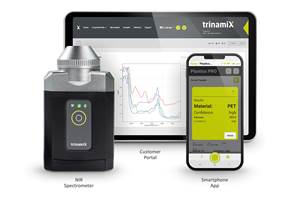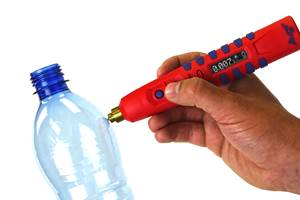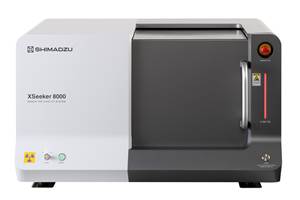Colloidal Silica Processing Aid Slashes Molding Cycle Times
Ultra-fine synthetic silica particles have been shown in laboratory and commercial field trials to reduce injection molding cycle times by 20% to 30% in polypropylene, filled and unfilled nylon, PBT, and ABS.
Ultra-fine synthetic silica particles have been shown in laboratory and commercial field trials to reduce injection molding cycle times by 20% to 30% in polypropylene, filled and unfilled nylon, PBT, and ABS. This processing advantage is accompanied by retention and even improvement of key physical properties. Other reported benefits are improved color dispersion
and reduced flow lines and surface defects. What’s more, the silica additive is said to mix easily with resin pellets in a blender, so melt pre-compounding is not required.
Nan-O-Sil ASD additive is high-purity, amorphous, colloidal silica in the form of a white powder. The spherical particles range in size from 0.02 to 0.55 microns (20 to 550 nanometers). Nan-O-Sil ASD is manufactured and marketed by Energy Strategy Associates, Inc., which has been working with technical consulting and R&D firm Rheo-Plast Associates to develop applications for this additive. Headed by Dr. Pravin L. Shah, Rheo-Plast specializes in polymer rheology and its application to extrusion, injection molding, and compounding of engineering plastics and blends/alloys. Rheo-Plast conducted laboratory testing of Nan-O-Sil in a variety of resins. Dr. Shah supplied the test results to Plastics Technology for this article.
EXPERIMENTAL RESULTS
Injection molded sample bars were obtained by first tumbling resin pellets with Nan-O-Sil ASD for 15 min in a Conair blender. The additive coated the pellets well and uniformly, Shah reports.
| Table 1—Faster Injection Molding Cycles With Nan-O-Sil ASD | |
| Material w/ 0.8% Nan-O-Sil | Avg. Cycle Time Reduction |
| PP, unfilled | 22% |
| Nylon 6, unfilled | 24% |
| Nylon 66, 33% glass | 32% |
| PBT, unfilled | 26% |
| ABS, unfilled | 25% |
The most dramatic results with Nan-O-Sil ASD are the cycle-time reductions for PP, unfilled nylon 6, glass-filled nylon 66, unfilled PBT, and ABS (see Table 1). The additive also shows utility as a reinforcing filler that can raise the stiffness of PP and both stiffness and strength of nylon 6 and PBT (Tables 2 to 5). Depending on the resin and the amount of Nan-O-Sil used, there was little or no sacrifice of other properties, such as elongation or toughness.
In glass-filled nylons, using larger amounts of Nan-O-Sil ASD appears to have potential for reducing the amount of glass fiber required to improve strength and stiffness. One trial compared the physical properties of 13% glass or 10% Nan-O-Sil in nylon 6. As shown in Table 4, colloidal silica imparted a greater increase in tensile strength and flexural modulus than did the glass fiber. According to Shah, an in-depth study of combinations of Nan-O-Sil ASD and glass fiber is under way and results will be published next year.
HOW IT WORKS
Although the precise mechanism by which Nan-O-Sil ASD reduces cycle times and improves strength properties of molded plastics is still unclear, Shah says the additive has been shown to work at low addition levels of 0.4% to 0.8% as a heat sink to reduce the amount of cooling required during molding. Based on Brabender torque rheometer data, he also postulates that the additive works as a processing aid to reduce the shear gradient at the gate and facilitate melt flow orientation.
Also not clearly understood at present is the apparent melting-point depression observed in PP, though no such effect was evident in nylon. Further work is under way to determine the additive’s behavior in melt processing.
| Table 2—Nan-O-Sil ASD in Polypropylene | ||||||||
| Material | Tensile Str. @ Yield, psi | Elongation @ Yield, | Tensile Mod., psi | Gardner Impact, in.-lb/in. | Flexural | Flex. Str., psi | MFI, g/10 min | Melt Point, C |
| PP Control | 3000 | 9.7 | 145,000 | 2.18 | 112,000 | 3350 | 8 | 168 |
| PP/0.4% Nan-O-Sil | 3020 | 8.9 | 151,000 | 2.15 | 122,000 | 3570 | 8.2 | 163 |
| PP/0.8% Nan-O-Sil | 2930 | 8.2 | 144,000 | 2.12 | 118,000 | 3520 | 8.3 | 160 |
| TABLE 3—Nan-O-Sil ASD in Nylon 6 | |||||||
| Material | Tens. Str. @ Yield, psi | Elongation @ Yield, % | Tensile Mod., psi | Gardner Impact, in.-lb/in. | Flexural Modulus, psi | Flexural Strength, psi | HDT @ 66 psi, F |
| Nylon 6 Control | 8710 | 4.5 | 315,000 | 2.18 | 224,000 | 9300 | 140 |
| Nylon 6 + 0.4% Nan-O-Sil | 8760 | 4.5 | 320,000 | 2.18 | 227,000 | 9330 | 140 |
| Nylon 6 + 0.8% Nan-O-Sil | 9020 | 4.6 | 320,000 | 2.15 | 237,000 | 9840 | 140 |
| TABLE 4—Nan-O-Sil ASD Vs. Glass Fiber in Nylon 6 | |||||||
| Material | Tensile Str. @ Yield, psi | Elongation @ Yield, % | Tensile Mod., psi | Gardner Impact, in.-lb/in. | Flexural Modulus, psi | Flexural Strength, psi | HDT @ 66 psi, F |
| Nylon 6 Control | 8710 | 4.5 | 315,000 | 2.18 | 224,000 | 9300 | 140 |
| Nylon 6 + 13% Glass | 8760 | 4.5 | 320,000 | 2.18 | 227,000 | 9330 | 140 |
| Nylon 6 + 10% Nan-O-Sil | 9020 | 4.6 | 320,000 | 2.15 | 237,000 | 9840 | 140 |
| Table 5—Nan-O-Sil ASD in PBT | |||||||
| Material | Tensile Str. @ Yield, psi | Elongation @ Yield, % | Tensile Modulus, psi | Gardner Impact, in.-lb/in. | Flexural Modulus, psi | Flex. Str., psi | MFI, g/10 min |
| PBT Control | 7400 | 3.6 | 145,000 | 2.18 | 355,000 | 3350 | 8 |
| PBT+ 0.4% Nan-O-Sil | 7400 | 3.4 | 151,000 | 2.14 | 374,000 | 3570 | 8.2 |
| PBT+ 0.8% Nan-O-Sil | 7600 | 3.2 | 144,000 | 2.1 | 380,000 | 3520 | 8.1 |
Related Content
Comprehensive Optical Inspection for PET Preforms
Delta Engineering teams with Intravis to inspect preform mouth, body, thread and color.
Read MoreHandheld NIR Instrument Distinguishes PET from PETG
Mobile spectroscopy from trinamiX detects more than 30 different plastics—and now PET vs. PETG as an aid to recycling.
Read MoreDual-Mode Portable Thickness Gauge for Packaging
Hand-held “pen” measures sheets, containers, panels, large parts with magnetic or capacitance mode; controlled by Bluetooth phone app.
Read MoreX-Ray Vision Inside Parts Gets More Affordable for Processors
Shimadzu’s new benchtop x-ray CT scanner provides internal and external metrology and flaw detection at a fraction of the previous cost.
Read MoreRead Next
Processor Turns to AI to Help Keep Machines Humming
At captive processor McConkey, a new generation of artificial intelligence models, highlighted by ChatGPT, is helping it wade through the shortage of skilled labor and keep its production lines churning out good parts.
Read MoreAdvanced Recycling: Beyond Pyrolysis
Consumer-product brand owners increasingly see advanced chemical recycling as a necessary complement to mechanical recycling if they are to meet ambitious goals for a circular economy in the next decade. Dozens of technology providers are developing new technologies to overcome the limitations of existing pyrolysis methods and to commercialize various alternative approaches to chemical recycling of plastics.
Read More














.png;maxWidth=300;quality=90)








